FlashGrid Cluster
for Oracle RAC on AWS

FlashGrid vs. VMware Cloud for running Oracle RAC on AWS
FlashGrid vs. VMware Cloud
for running Oracle RAC on AWS
FlashGrid welcomes VMware Cloud on AWS as an alternative solution for running Oracle RAC on AWS. However, for customers who primarily use AWS native EC2 environment FlashGrid offers a much more practical solution. And even for those customers who use primarily VMware Cloud on AWS, FlashGrid offers substantial advantages that justify running Oracle RAC clusters in the native AWS EC2 environment.
Below is a comparison of the two solutions. Each item has a link to more details.
FlashGrid
VMware Cloud on AWS
Choice of EC2 instance types
Having a wide selection of EC2 instance types to choose from contributes to:
- More flexibility
- Higher performance
- Lower costs
FlashGrid supports over 40 different VM types to choose from:
- R5, R4: most popular
- M5, M4: lower memory to CPU ratio
- Z1D: low CPU core count with high frequency
- i3: up to 15 TB of local NVMe SSDs per node for max read throughput
- X1, X1E: large memory and CPU
- u-6tb1.metal, u-9tb1.metal, u-12tb1.metal: extra large CPU and memory
- Future instance types as they become available
VMware Cloud on AWS supports only two instance types: R5.metal for use with EBS, and i3.metal for use with local SSDs, which limits the opportunities to size the cluster for optimal price and performance.
EC2 instance sizes
FlashGrid can be deployed on VM instances of virtually any sizes. This allows precisely sizing the cluster to meet the performance and cost requirements.
VMware Cloud on AWS can be deployed only on full-size EC2 instances. This creates major cost overhead unless full instance size is required or other (non-RAC) VM resources also need to be deployed on VMware.
Bare-metal as RAC nodes
FlashGrid supports using AWS bare metal instances as RAC nodes for maximum performance and reliability. Supported bare metal instance types include r5.metal, m5.metal, i3.metal, z1d.metal, u-6tb1.metal, u-9tb1.metal, and u-12tb1.metal.
With VMware Cloud on AWS, RAC must be deployed on VMware-managed VMs, making it impossible to leverage the benefits of bare metal.
Combining local NVMe SSD and EBS storage
FlashGrid allows combining both the local NVMe SSD based storage and EBS storage, thus accommodating both fast and large capacity data tiers.
VMware Cloud on AWS offers choice of either local NVMe SSDs, or EBS, but does not allow combining the two.
Native mechanisms for disk group management and data mirroring
FlashGrid does not introduce proprietary data management or data mirroring code in the data path. All data management is performed by native Oracle ASM (Automatic Storage Manager) with Normal or High Redundancy disk groups, thus eliminating risks to data consistency or integrity.
With VMware Cloud on AWS, data mirroring is delegated to vSAN with RAID-1 or RAID-5, adding an external layer and overhead to the solution stack.
Read I/O from local disks
FlashGrid Read-Local Technology ™ utilizes Oracle ASM Preferred Read functionality to ensure that read requests are served from local storage that is attached to the same node that is serving the request. With 2- or 3-node FlashGrids, each node has full set of user data, and therefore reading from local disks provides the following benefits:
- Maximizing read throughout
- Maximizing read IOPS
- Minimizing read latency
- Minimizing network consumption
EBS sizing flexibility
With FlashGrid, any number of EBS volumes of any size can be attached to database nodes, providing a very granular method of sizing the storage. Run extra large databases of 100 TB or more. Or minimize costs for small and test clusters with 1TB or smaller capacities. Resizing storage can be done with no downtime.
VMware on AWS storage is limited to the range of 15 to 35TB per host with 5TB increments, making the solution practical only for a narrow band of database sizes. Users with smaller databases will have to pay high excessive storage costs. Users with large databases might have to provision extra hosts, which increases costs and complexity unnecessarily.
Single cloud account required
Only AWS account is required to deploy and use FlashGrid, reducing management overhead compared to RAC on VMware Cloud on AWS, where both AWS and VMware accounts are necessary.
Single vendor billing
FlashGrid fees are billed by AWS through the AWS Marketplace AMI offering. Using FlashGrid does not require direct billing by FlashGrid, keeping all billing with single trusted vendor, AWS.
With VMware Cloud on AWS customers will need to maintain two vendor relationships, AWS and VMware.
Deployment automation
FlashGrid Launcher generates custom AWS CloudFormation templates for automated Infrastructure-as-Code deployment of AWS EC2 resources, FlashGrid software, Oracle Grid Infrastructure and Database, resulting in
- Dramatically shorter deployment timelines
- Eliminating human errors
- Repeatable process
There is no deployment automation for RAC on VMware Cloud on AWS.
Comprehensive validation
There is a significant difference between a solution working in principle and an actual enterprise-grade validated product. Continuous extensive validation of FlashGrid with various database versions, latest release updates, and Linux kernel updates ensures smooth database operation during the entire life of your applications.
24/7 support with Oracle expertise
FlashGrid is delivered complete with 24/7 support by highly skilled engineers with expertise in both Oracle and AWS technologies. See the FlashGrid Technical Support Services description.
Proven in production use
Multiple enterprise customers use FlashGrid in production for mission critical applications, some since 2017. Read case studies with select customers.







